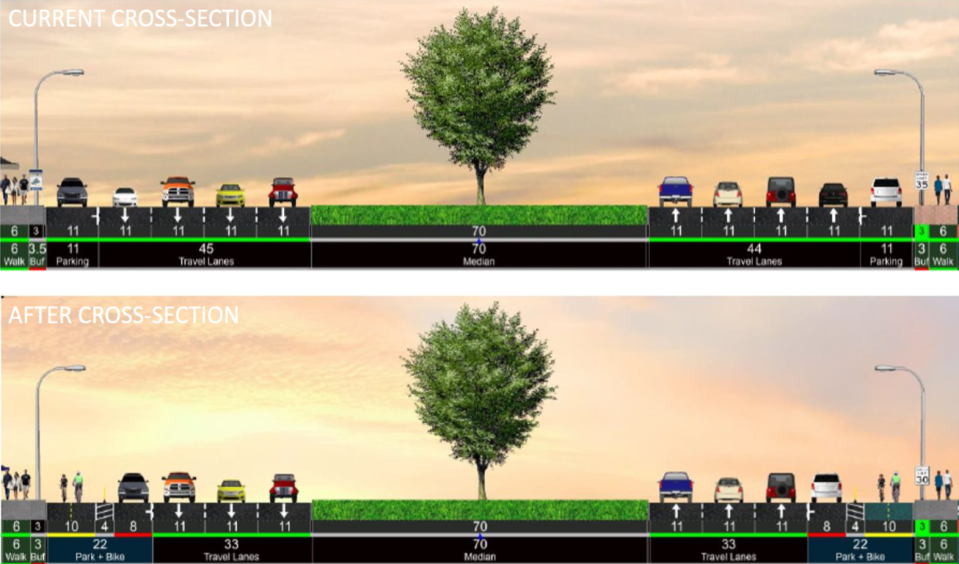At birthplace of Dream Cruise, Woodward Avenue to lose lanes for safer cycling and walking

The broad avenue often called America's "signature highway" for cruising in hot rods is about to turn the tables on car buffs.
Woodward Avenue, smack in the birthplace of its namesake Dream Cruise at 9 Mile Road, will get a redesign aimed at slowing cars while safeguarding pedestrians and cyclists, according to city officials in Ferndale.
The design change, already seen on major streets around metro Detroit, is called a road diet because the roadway will lose a lane in each direction, making room for protected bike lanes while providing shorter and safer crossings for pedestrians.
Ferndale officials announced Tuesday that their city and Pleasant Ridge had been awarded more than $2.3 million in federal funding for the project on M-1, Woodward's state highway designation, between 8 Mile and I-696. The 2-mile stretch is traveled by tens of thousands of commuters a day, but not nearly as many as it once was, according to state traffic counts.
The project will make Woodward look like much of East Jefferson in Detroit, where cars are directed to park away from curbs. That provides a protective buffer for cyclists riding at the roadway’s edge. The Woodward plan differs from East Jefferson in that each side of the roadway would have two-way bike lanes.
Todd Scott, executive director of the nonprofit Detroit Greenways Coalition, said Tuesday he was delighted to hear that the grant had been approved, and added: “We'd like to see this design continued south of Eight Mile and eventually connect with the Cass Avenue bike lanes. It's been part of our Zoo-to-the-River vision for more than a decade.”
More: State agrees to unwind Pontiac's Woodward 'Loop' that leaders say strangles their downtown
More: Royal Oak police seize wandering 50-pound African cats and ship them to sanctuary, chief says
Much of the project's cost is built into the plans of state highway engineers for repaving this stretch of Woodward, Ferndale Mayor Melanie Piana said.

“We’re just using this opportunity with MDOT to make the road much safer for everyone,” Piana said. The roadway’s current design, with five lanes of traffic going each way, was created when traffic volumes peaked at 100,000 vehicles a day decades ago, Piana said.
“Now, our peak is about 40,000," Piana said. She estimated that, if normal traffic patterns resume after the pandemic subsides, that drivers might need 30 more seconds to go from 8 Mile to I-696 during a rush-hour peak after the avenue is narrowed. But that may just mean that they won't risk getting a speeding ticket.
"The whole goal of the project is to encourage drivers to go the posted speed limit of 35 miles per hour. We’re seeing a lot of drivers going 45 or more. We had 900 crashes between 2014 and 2019, with some serious injuries,” she said.

A federal grant of $2.34 million will be administered jointly by MDOT and the Southeast Michigan Council of Governments. Matching funds will come from Ferndale ($1.23 million) and Pleasant Ridge ($140,000) although not from city coffers but instead via state Act 51, which dedicates road funds for local governments from state taxes on gasoline and vehicle registrations.
Scott, an avid cyclist who lives in Royal Oak, said he wrote a letter in support of the two cities' grant requests, which included this statement: "I have personally ridden this portion of Woodward for the past 25 years. I cannot count the number of times motorists have driven carelessly by me, physically bullied me with their vehicle, and even threatened me with assault. This happens monthly. No other road segment I ride is more dangerous to my personal safety than this one."
Three years of planning and multiple rounds of meetings with residents and business owners preceded the design, Ferndale officials said. Besides shrinking the roadway by one lane each way, the upgrade will include safety improvements to alleyways and sidewalks, improved visibility at intersections, and new wheelchair ramps at street corners.
According to a news release from the city of Ferndale, the project's design is scheduled to be done by April 2022, with initial work beginning in late August — after the Dream Cruise — and running through November. The remaining work will be completed in 2023, the release said.
Contact Bill Laitner: blaitner@freepress.com
This article originally appeared on Detroit Free Press: At Dream Cruise birthplace, Woodward to lose lanes for bikes, walkers

